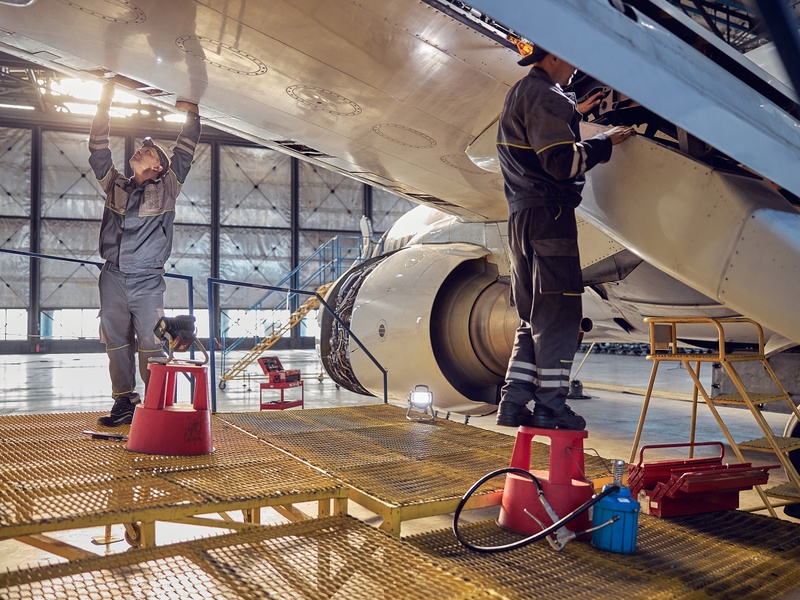Catapulting into a Future of Automated Aviation
Exploring advanced technologies and trends in the aerospace industry
- Manufacturing
Posted July 30, 2024
Advancing technology and driving trends in the Aerospace World
The Aerospace industry is growing rapidly. In fact, the global Aerospace market size was estimated at 321.5 billion USD in 2022 and is forecasted to reach around 678.17 billion USD over the next 10 years.
Overall, recent advances in technology, increasing private sector investment and rising demand for innovation are propelling growth in the sector. Every day we see more and more companies embrace new technologies aimed at accelerating both sustainability and efficiency.
More recently, Aerospace has witnessed a boom in new and emerging technologies which now dominate most topics across the industry. AI, machine learning, and computer vision continue to drive innovation; with AI being applied across the board from improving manufacturing processes to piloting fighter planes!
To no one’s surprise, sustainability is also a key trend encouraging industry growth. With aviation accounting for 3% of the worlds global CO2 emissions there is a push within the industry to reduce the overall carbon footprint and to adopt more sustainable and environmentally friendly practices. The industry is incorporating lightweight, durable materials that combine to reduce the weight of aircrafts, bettering fuel efficiency and releasing lower emissions. Moreover, there has been and continues to be increased investment into electric and hydro-electric propulsion systems, building upon a cleaner, more sustainable future.
The Rise of AI and Autonomous Flying; How is AI re-shaping the aviation industry?
With advancing technologies revolutionizing the world around us, AI is certainly becoming a normality within the aviation industry. The technologies are ensuring safety, enhancing efficiency, boosting customer experience, revolutionizing operational processes and allowing companies to maintain competitive advantage in the Aerospace industry.
Within flight and air traffic, AI can be utilised to automate repetitive tasks and analyse real-time data, with a view of reducing wait times, optimising flight routes and improving fuel efficiency. In terms of manufacturing, Aerospace OEM’s are leveraging AI to automate and improve factory operations and supply chains, contributing to faster build times, lower costs and improved productivity.
Probably the most utopian applications of today’s flight technologies are the advancements of AI flight control systems, pushing us towards a future of fully autonomous flight. Over the last 10 years there has been many automated aviation startups founded, with multiple automated flight control systems clocking 100’s of hours in the air.
Here are some of the most exciting aviation start-ups accelerating AI innovation throughout the industry:
Volocopter
- A pioneer of urban air mobility and fully electric aviation.
- Launched in 2011 with a focus on electric aircraft solutions for fast, sustainable travel.
- Aiming to be the first company to bring electric air taxis to Europe.
- Developing a “digital brain” called VoloIQ to manage their fleet service, infrastructure and flight operations
Klaus Seywald Head of Digital Strategy at Volocopter says:
“We will require real-time decisions and the transparency of our fleet, crew, batteries, vertiports, airspace, and more that the legacy aviation management systems do not support. An integrated digital platform — our VoloIQ — is a key pillar of our UAM [urban air mobility] ecosystem for eVTOL services to succeed globally and at scale.”
Xwing
- Founded in 2016, Xwing leads in the development of autonomous technology for aviation.
- Earlier in the year, Xwing was acquired by Joby, a California-based transportation company developing electric air taxis for commercial passenger service.
Donecle
- Alters how aircraft inspections are performed with its automated drone technology, ensuring inspections are up to 10x faster than traditional methods. The automated drones and advanced image analysis algorithms detect defects in aircrafts, landing gears and engines, optimising maintenance processes and increasing safety.
Reliable Robotics
- A California-based company also fuelling autonomous flying with an aim to make transportation safer and more efficient.
Sheild AI
- A California-based company developing AI-powered fighter pilots, drones and technology for military operations
The controversy behind an evolving industry
The rapidly evolving nature of artificial intelligence and advancing technologies are transforming many industries, and signifying a new era of efficiency, sustainability and safety.
One of the most significant benefits of AI in aviation is improved safety through predictive and proactive maintenance and real-time data analysis. AI is also certainly proving cost-effective in lots of industries, whether that be through improved efficiency, reducing human errors or completely eliminating the need for humans.
A downside to the implementation of AI within aviation could be the risk to jobs; either within aircraft maintenance or within the manufacturing and production process – even pilots aren’t safe!
Over the coming years, we will need to upskill significantly within software and algorithm developments to meet current and future demand for robotics and automation engineers. We’re already seeing massive skill shortages which are driving competition between start-ups and leaving some development teams understaffed.
Driving towards an alternative aviation landscape
The future of the aviation industry certainly incorporates a rise in autonomous flight technology, the development and uptake of sustainable flight options, and increasing efficiency through the utilisation of automation technologies.
There are still teething issues with a fully electric flight; the battery technology isn’t quite at the point that we would need it to be to fly any significant distances, but the uptake in hydro-electric development could propose significant short-term benefits.
There’s some very interesting development work being undertaken by OEM’s and propulsion manufacturers like GE Aerospace and their 10kV+ SiC hybrid technology which if all goes to plan will be used to retrofit the 50,000+ 737 size planes currently in the air.
In terms of the automated flight, it is still uncertain where the immediate value is for passenger flights, but the FAA are actively looking to certify autonomous flight control systems for agriculture purposes so next time you’re in a rural area, take a look across the fields and you might see a surprise!
Share this Blog
Centred around care, trust and respect
Shifting the Landscape for the Future of...
The bioprocessing industry is evolving and the space is shifting towards greener, smarter and more efficient technologies. Read Lexie's latest blog to learn why companies like MAGic Bioprocessing and Akadeum Life Sciences are transforming outdated downstream methods with innovative magnetic and microbubble solutions that cut waste, energy use, and complexity.

Lexie Farrar
Lexie primarily focuses on Precision Medicine, OMICS and CGT tools within the US and Europe. Lexie joined Jackson Hogg at the beginning of May 2024...

How to Prepare for a Video Interview ...
Read our blog to learn everything you need to know to prepare for a video interview.

Beth McParlin
Beth joined Jackson Hogg in February 2024 as a part-time Associate Consultant. She initially joined Jackson Hogg alongside her Fashion Marketing...

The Future of Hiring ...
The future of hiring is determined by the rapid rate of advancing technology and ongoing demands for flexible and hybrid working opportunities. See our insight into exactly how these elements help to predict the future of hiring.

Beth McParlin
Beth joined Jackson Hogg in February 2024 as a part-time Associate Consultant. She initially joined Jackson Hogg alongside her Fashion Marketing...



